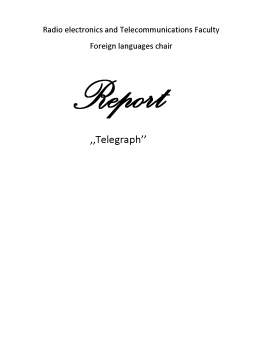Extras din referat
Telegraph is a system of communication employing electrical apparatus to transmit and receive signals in accordance with a code of electrical pulses. Originally the term telegraphy referred to any form of communication over long distances in which messages were transmitted by signs or sounds.
THE MORSE TELEGRAPH
The first electrical instruments for telegraphic transmission were invented in the United States by the American inventor Samuel F. B. Morse in 1837 and in Britain the same year by the British physicist Sir Charles Wheatstone in collaboration with the British engineer Sir William F. Cooke. Morse used a simple code in which messages were transmitted by electric pulses passing over a single wire. Morse's apparatus, which sent the first public telegram in 1844, resembled a simple electric switch. It allowed current to pass for a prescribed length of time and then shut it off, all at the pressure of a finger. The original Morse receiver had an electromagnetically controlled pencil that made marks on paper tape moving over a clockwork-operated cylinder. The marks varied with the duration of the electric current passing through the wires of the electric magnet and took the written form of dots and dashes.
While experimenting with his instrument, Morse found that signals could be transmitted successfully for only about 32 km (20 mi). Beyond that distance the signals grew too weak to be recorded. Morse and his associates therefore developed a relay apparatus that could be attached to the telegraph line 32 km from the signal station to repeat signals automatically and send them an additional 32 km. The relay consisted of a switch operated by an electromagnet. An impulse entering the coil of the magnet caused an armature to rotate and close an independent circuit actuated by a battery. This action sent a fresh pulse of current into the line, and this pulse in turn activated successive relays until the receiver was reached. A few years after Morse developed his receiving instrument and demonstrated it successfully, telegraph operators discovered that it was possible to distinguish dots and dashes by sound alone, and the Morse recording apparatus was therefore discarded . The other fundamental principles of the Morse system continued in use in wire-telegraph circuits, however.
Because telegraphy was too expensive for widespread use, several means of sending several messages simultaneously over a single line were developed. In duplex telegraphy, the earliest advance of this kind, one message can be transmitted simultaneously in each direction between two stations. In quadruplex telegraphy, invented in 1874 by the American engineer Thomas Edison, two messages were transmitted in each direction simultaneously. In 1915 multiplex telegraphy came into use, permitting the transmission of eight or more messages simultaneously. Because of this and the development of teleprinting machines during the middle 1920s, the Morse manual telegraph system of code and key was gradually discontinued for commercial use and replaced by automatic wire and wireless radio-wave methods of transmission.
AUTOMATIC TELEGRAPH SYSTEMS
There are two basic systems of modern telegraphic communication: the teleprinting system (teletype), which is still in use, and the facsimile reproduction system, which became obsolete in the 1980s.
Teleprinting
In teleprinting, the message is received in the form of typed words on a paper form. In this system each letter of the alphabet is represented by one of 31 combinations of five equal-interval electronic impulses, with the sequence of used and unused intervals determining the letter. The start-stop printing code uses seven pulses for each character, the first pulse indicating the beginning and the seventh pulse the end of the letter.
The transmitter or teletypewriter consists of a typewriter like keyboard and may or may not record the message on tape before it is transmitted. The receiver is basically like a typewriter without a keyboard that prints the message on a tape or a paper form. Most machines in the start-stop system are both transmitters and receivers. News organizations were among the major users of the teletype and similar communications systems. By the early 1990s, however, press associations and broadcast media transmitted both text and pictures electronically via satellite.
Facsimile Reproduction
Facsimile telegraph systems, which send and receive images and text, have been rendered largely obsolete by facsimile transmission, commonly referred to as fax.
TELEGRAPH CARRIER MEDIA
The electrical impulses that make up telegraph messages may be carried through wire circuits or may be broadcast as radio waves.
When Morse invented the telegraph, the only way that a message could be carried from one point to another was by wires strung directly from the transmitting devic e to the receiver, regardless of the distance. The wire could carry only one message at a time, and reamplification and signal correction devices had to be set up at regular points along the line. By utilizing carrier currents, which are alternating currents of a number of different frequencies, a single pair of wires can simultaneously transmit hundreds of messages, for each frequency represents a transmission channel. The various channels are combined at the sending station into the carrier current transmitted by the telegraph wires. At the receiving end the carrier current is passed through electrical filters, each of which transmits only a particular frequency to an appropriate receiving device. Thus, a great number of individual channels may be obtained with only one electrical circuit.
Preview document
Conținut arhivă zip
- The Telegraph.doc













